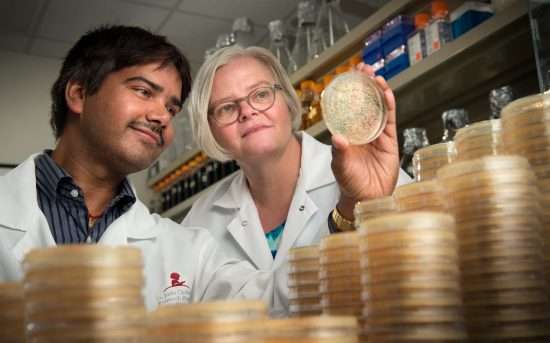Mutant yeast reveals details of the aberrant genomic machinery of children's high-grade gliomas

St. Jude Children's Research Hospital biologists have used engineered yeast cells to discover how a mutation that is frequently found in pediatric brain tumor high-grade glioma triggers a cascade of genomic malfunctions.
The basic discovery is an important first step toward a targeted therapy for the aggressive brain cancer, which has a very low survival rate. Current treatments for the glioma—surgery, radiotherapy and chemotherapy—produce less than a 20 percent five-year survival for patients. The National Center for Health Statistics found brain cancer is the most deadly type of cancer in pediatric patients.
Led by Janet Partridge, Ph.D., an associate member in the Department of Pathology, the researchers published their findings today in the scientific journal eLife.
The cancer-causing mutation they studied is unusual because it is not in a gene that when mutated produces an aberrant enzyme that triggers cancer. Most cancer-causing genes are blueprints for such enzymes in signaling pathways in cells—the biological equivalent of computer circuits.
Rather, the mutation the researchers studied is in a gene that is the blueprint for a protein called a histone. Histones are the biological "factory workers" in the cell's machinery for managing DNA. Histones protect DNA from damage, control when genes switch on or off and influence how DNA is copied as one cell divides to produce two new cells.
Partridge and her colleagues studied a single genetic defect in one histone, called histone H3. The histone is the cellular equivalent of a floating worker who ranges the whole factory floor to operate throughout the production line. Similarly, H3 plays a role beyond just replicating DNA, but in the whole cell division cycle.
While yeast cells are in many ways far different from human cells, they do share the same fundamental machinery for managing DNA. Partridge and her colleagues took advantage of the simplicity of the yeast cells to study the cancer-associated mutation without the more complex machinery of human cells.
The mutation is known to arise in about 20 percent of pediatric high-grade gliomas. "Although this mutation appears central to this form of glioma, almost nothing was known about what it was doing in the cell," Partridge said.
The scientists engineered a yeast to have only the mutant histone H3.
"Now the whole organism is populated with the mutant H3, which allows us to really get a detailed handle on what the biology of this mutation is," Partridge said.
Although the mutation they studied, called G34R, is very subtle, it creates a major cascade of effects in the yeast cell. Their detailed studies of the engineered yeast revealed that the mutation produced distinctive effects on the molecular changes that the histone undergoes in its function. The researchers found evidence that the mutation caused cells to lose chromosomes. In addition, it also compromised the yeast cells' ability to separate DNA-containing chromosomes after they have been copied. The latter is a critical step in dividing cells. The mutant yeast was also deficient in repairing broken DNA strands and in overcoming molecular glitches that occur when DNA is copied.
The details the researchers discovered about the malfunctioning machinery in yeast will open a new pathway to mapping the previously uncharted machinery underlying this form of glioma, Partridge said.
"These processes are highly similar between yeast and mammalian cells," she said. "So the challenge now for our colleagues working with the more complex human gliomas with this mutation is to find out whether what we have discovered is relevant to their work."
In particular, she said, such discoveries about cancer-causing histone mutations will aid cancer biologists in understanding cancers that arise from such mutations, rather than mutations in genes that are the blueprints for enzymes.
The latest findings have only just opened the door for explorations of a subtle and complex mechanism of cancer. For example, Partridge said, the G34R defect in H3 in the gliomas is found along with mutations in completely unrelated cancer-causing genes—an association they cannot yet explain. Figuring out how and why these mutations are linked will be the next challenge.
More information: Rajesh K Yadav et al. Histone H3G34R mutation causes replication stress, homologous recombination defects and genomic instability in S. pombe, eLife (2017). DOI: 10.7554/eLife.27406

















